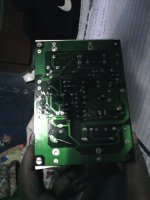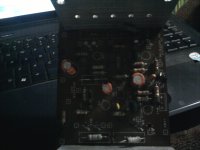Thanks Lee.
I recall the original having BFY51's and so on - never did know how the original managed to work above about 40V except that the base and emitter resistors of Tr5 keep the gain very low (base=220 ohms, emitter=100 ohms) and to compensate the input diff pair have to work at a rather higher current than is necessary.
This design could be improved now that it uses BD139's for the VAS - and in principle should also be able to use BD149/BD140 pair for the drivers, not the slow BD711/712 pair.
50V rails is I suspect too high for safety, even though I have often mentioned that the original 2N3055 spec. requires 100V transistors in the epi base technology to meet the RCA standard 100V Vcbo. I'd keep the rails below 45V which is fine for 70W into 8 ohms.
Using a resistor-capacitor decoupled supply in the tail of the diff pair is usually asking for trouble in the form of turn-on thumps.
I'd use R4 for the emitter of another PNP , connecting the collector to the emitters of the diff pair, and adding two diodes and a bias resistor across the Zener, but the values of R4, R3 and R13 should be changed.
C5 could then be omitted, and R8 (?), the bias resistor of the current source to the VAS, can be changed and connected to ground.
C3 across the Zener can be reduced to something like 10 nF, which avoids large time constants. These mods. remove all the large time constants which could cause thump (it is noted that C5 may help by keeping the current low initially) and allow the diff pair to reach operating current at a low power supply voltage.
R 3 could be 680 ohms and D1 disconnected from R3, but kept in place and adding a second diode in series to th enegative rail would provide a current limit clamp for Tr5. R13 could be 10 ohms.
For a couple of extra capacitors and diodes in the power supply, a double voltage negative rail could be provided allowing R14 to be connected to it so that the input stage is not a limiting factor. It is also better for Tr5 not to saturate first, as this keeps the phase correct in clipping, but these are not such important mods. for a generic PA amp.
However, the previous mods should allow the VAS gain to improve and reduce overall distortion to around 0.02% rather than "<0.1%".
John
I have this circuit at home and still rocking. Can VI limiter is possible to add into this circuit? I'm planning to increase supply voltage from +-40vdc into +- 82 vdc and change all transistor that can hold into higher voltage.
regards.
I still have one of the 225W models working perfectly in my current set-up. Do you know if it would be able to drive at 2 ohms?
thanks
2Ω is a severe load. If the design uses the original 2N3055/2955 devices then a bit of work using more modern devices such as the MJ21193/4 would be worthwhile. For continued high power operation larger heatsinks might be needed and the PSU uprated. It depends what you want from it.
Hi bluevanman63
Think this was the one with two pairs 2N3055/MJ2955 in the output?
If so the one I'm thinking of had BFY50's and suchlike. BUt these were never 80V transistors, had to use Vcer spec. which seemed dubious.
You could probably use 2N3019 for all NPN's and 2N4033's as PNP's for input & driver in TO-39 cans or with a bit of persuasion BD139/BD140's for all small signal devices.
cheers
John
i wonder, what is the operating temperature of the 2n3019 & 2n4033? Are they really hot? Cause i only saw a small heat sink is snap into the 39
Here are the pages from the magazine article. Note, these are for the later (mk2) version of the amplifier. The original had a lot of wiring between the heatsink and the circuit board, as well as you had to drill the heatsink yourself. This version substitutes an L-shaped metal bracket similar to what the 50w bipolar and 150w MOSFET amps used.
As for the comments about Maplin turning into Tandy, it really is a shame. If only they'd just make their excellent PCBs available again, the components you can get pretty much anywhere (for this amp at least).
Back in time, Tandy was once a good place to buy electronics. I remember a kid at school gave me a kit he'd got from there, and could never build. He'd soldered two capacitors on the board, without trimming the leads down, and the soldering looked like pidgeon pooh, before he gave up. It was a quasi-complimentary design using two 2N3055s, I finished it off and added a power supply, and it worked well for many years.
Lee.
dear lee,
can you send me its pcb in pdf form.
thanks
Does anyone have any info on this amp. Circuit Dia would be fantastic. I asked Maplin about back issues with no luck.
Please help, i'm desperate to fix it.
I have it, along with two working modules.
I will find it and post it here later today.
Partslist and schematics?
Here is a link to the schematic and parts list.
http://www.diyaudio.com/forums/swap...s-bi-polar-amp-module-wanted.html#post3477657
http://www.diyaudio.com/forums/swap...s-bi-polar-amp-module-wanted.html#post3477657
hey guys, i want to run this circuit at +- 80 vdc, need expert diy's for any modification of maplin circuit.
see post 64 and 64, if you want an amp that can run on +- 80 vdc, there are many examples here, please look at the amps by APEX or Workhorse....
what is the value of pot at input to earth?An externally hosted image should be here but it was not working when we last tested it.
what is the value of pot at input to earth?
10K should be ok as a volume control.
- Status
- This old topic is closed. If you want to reopen this topic, contact a moderator using the "Report Post" button.
- Home
- Amplifiers
- Solid State
- Maplin 160W (225W) bipolar amplifier design

